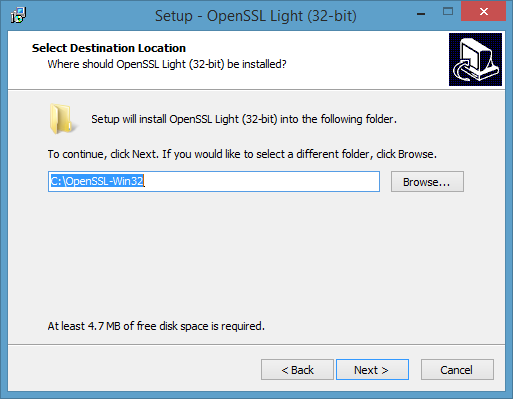

- #Install openssl windows 10 how to
- #Install openssl windows 10 install
- #Install openssl windows 10 update
- #Install openssl windows 10 for windows 10
With the help of this toolkit, you will be able to generate private keys, create CSRs, generate and install your SSL/TLS certificate, identify certificate information, encrypt and decrypt data, verify checksums, and monitor secure web server connectivity with OpenSSL, and check for revoked website certificates.

#Install openssl windows 10 how to
In this tutorial we saw, how to install the OpenSSL toolkit step by step and in detail. If it returns you with the OpenSSL version, this means your installation has been successful. You can also run the following command to see if the OpenSSL toolkit has been successfully installed or not. To check OpenSSL installation and version, run the command below: Using nano editor, edit the /etc/environment file:Īdd this line to the file. Next, reload the dynamic link with the following command: Now paste the following path in the configuration file: Next, open the openssl-1.1.1k.conf configuration file with nano editor command like this: To do that go to the directory as shown below: Now that the installation is all done, we will link the shared libraries so that they load at runtime without giving any errors. Now that we have downloaded the OpenSSL toolkit, we will configure it in this step with the help of the following commands: Next, go to the src directory following the path shown below where you will download OpenSSL tool’s source code to install it.įollow these commands to download the code from its official page: However, when I go through Setting to 'add an optional feature', I am not seeing any features or apps listed.
#Install openssl windows 10 for windows 10
This package holds development support files. Hi, I am looking for Windows 10 OpenSSL beta.
#Install openssl windows 10 update
Apt Update only updates the packages, and apt upgrade installs them.Īlso, run the following command to install the zlib1g-dev package. Let’s get started! Installation Guide: Step 1: Update and Upgradeīefore installing any new application or tool, make a habit of running the update command as it updates the latest versions of the packages that are already there in your system.Īfter updating the packages, you have to run the upgrade command for the new versions of the packages to be installed on your system. This tutorial is compatible with all recent Ubuntu versions incl. This document assumes you hold basic knowledge of Linux and you have a little bit of practice of Linux terminal. In this tutorial, you will see how you can easily install the OpenSSL library with the help of a few simple steps. I'm assuming there is no generally easy way to update the version without removing it and installing the version I want. I am just generally concerned about having that version on the remote desktop because of the vulnerability. I've tried following a previous tutorial and another one for MSVC2017 but no luck in resolving the errors or getting xhttp.responseText. I can be sure it's 1.1.1h as I ran 'openssl version' in PowerShell and it returned the version. I ran C:\Qt\MaintenanceTool.exe to install Developer and Designer Tools > OpenSSL 1.1.1d Toolkit. If the command doesn’t return you with a version number, this means the OpenSSL toolkit is missing, and you need to install it to use it. Windows 10 64-bit OS, running MSVC2017 QML project. This command will tell you the version of the OpenSSL library installed on your system. To check if your Linux system has on it or not, run the following command:

However, in some cases, the OpenSSL library is not there so you have to install it yourself. Most Linux distributions come pre-installed with the OpenSSL library. This commercial-grade and robust toolkit is widely used by various programs like PHP, Internet servers, comprising the majority of HTTPS websites. If (xhttp.readyState = 4 & xhttp.OpenSSL Cryptography and SSL/TLS Toolkit is an open-source, full-featured package used in Transport Layer Security (TLS) and Secure Socket Layer (SSL) protocols to provide secure communication between client and server. INCLUDEPATH += C:\Qt\Tools\OpenSSL\Win_x86\includeĬomponent.onCompleted: getPage(logResults) LIBS += -LC:\Qt\Tools\OpenSSL\Win_x86\lib -llibcrypto pro LIBS += -LC:\Qt\Tools\OpenSSL\Win_x86\lib -llibssl


 0 kommentar(er)
0 kommentar(er)
